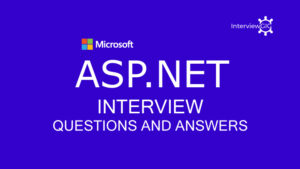Top .Net Assembly Interview Questions and Answers: Below, we have covered detailed answers to the .Net Assembly Interview Questions Which will be helpful to freshers and experienced Professionals. All the best for your interview Preparation.
Assemblies are the basic building blocks required for any application to function in the .NET realm. They are partially compiled code libraries that form the fundamental unit of deployment, versioning, activation scoping, reuse, and security. Typically, assemblies provide a collection of types and resources that work together to form a logical unit of functionality. They are the smallest deployable units of code in .NET. Compared to the executable files assemblies are far more reliable, more secure, and easy to manage. An assembly contains a lot more than the Microsoft Intermediate Language (MSIL) code that is compiled and run by the Common Language Runtime (CLR). In other words, you can say that an assembly is a set of one or more modules and classes compiled in MSIL, and metadata that describes the assembly itself, as well as the functionalities of the assembly classes.
An assembly is a logical unit that is made up of the following four different types of components:
The following are the two types of assemblies: For example, imagine that you have created a DLL containing information about your business logic. This DLL can be used by your client application. In order to run the client application, the DLL must be included in the same folder in which the client application has been installed. This makes the assembly private to your application. Now suppose that the DLL needs to be reused in different applications. Therefore, instead of copying the DLL in every client application folder, it can be placed in the global assembly cache using the GAC tool. These assemblies are called shared assemblies.
No, a DLL file can contain the compiled code of only one programming language.
There is no limit to the maximum number of classes that can be contained in a DLL file.
Satellite assemblies are assemblies that are used to deploy language and culture specific resources for an application. In an application, a separate product ID is assigned to each language and a satellite assembly is installed in a language specific sub-directory.
No, versioning is not applicable to private assemblies as these assemblies reside in their individual folders. Versioning can be applied to GAC only.
An assembly metadata describes every data type and member defined in the code. It stores the description of an assembly, such as name, version, culture, public key of an assembly along with the types exported, other assemblies’ dependent on this assembly, and security permissions needed to run the application. In addition, it stores the description of types, such as the name, visibility, base class, interfaces implemented, and members, such as methods, fields, properties, events, and nested types. It also stores attributes. Metadata is stored in binary format. Therefore, metadata of an assembly is sharable among applications that execute on various platforms. It can also be exported to other applications to give information about the services and various features of an application.
Assemblies maintain all their information in a special unit called the manifest. Every assembly has a manifest. The followings are the contents of an Assembly Manifest:
False.
The Native Image Generator (Ngen.exe) is a tool that creates a native image from an assembly and stores that image to native image cache on the computer. Whenever, an assembly is run, this native image is automatically used to compile the original assembly. In this way, this tool improves the performance of the managed application by loading and executing an assembly faster. Note that native images are files that consist of compiled processor-specific machine code. The Ngen.exe tool installs these files on to the local computer.
The Ildasm.exe utility.
The Strong Name utility (sn.exe) helps in creating unique public-private key pair files that are called strong name files and signing assemblies with them. It also allows key management, signature generation, and signature verification.
You can use different versions of private assemblies in the same application without a re-build by specifying the assembly version in the AssemblyInfo.cs or AssemblyInfo.vb file.
GAC is a central repository (cache) in a system in which assemblies are registered to share among various applications that execute on local or remote machines. .NET Framework provides the GAC tool (gacutil.exe utility), which is used to view and change the content of GAC of a system. Adding new assemblies to GAC and removing assemblies from GAC are some of the tasks that can be performed by using the gacutil.exe utility. GAC can contain multiple versions of the same .NET assembly. CLR checks GAC for a requested assembly before using information of configuration files. The gacutil.exe /i <assembly name> – is the command that is used to install an assembly in GAC. Users use the Command Prompt of Visual Studio to install an assembly in GAC by using this command. You can see all the assemblies installed in the GAC using the GAC viewer, which is located at the <WinDrive>:<WinDir>\assembly directory, where <WinDir> is windows in Windows XP or windows in Windows Vista or WinNT in Windows 2000. Apart from the list of assemblies, the assembly viewer also shows relevant information, such as the global assembly name, version, culture, and the public key token.
Information for the version of assembly is stored inside the assembly manifest.
Whenever, an assembly is deployed in GAC to make it shared, a strong name needs to be assigned to it for its unique identification. A strong name contains an assembly’s complete identity – the assembly name, version number, and culture information of an assembly. A public key and a digital signature, generated over the assembly, are also contained in a strong name. A strong name makes an assembly identical in GAC.
EXE DLL
An assembly can be referenced by using the gacutil.exe utility with the /r option. The /r option requires a reference type, a reference ID, and a description.
True.
The namespace keyword is used to declare a scope. This namespace scope lets you organize code and gives you a way to create globally unique types. Within a namespace, you can declare one or more of the following types: Whether or not you explicitly declare a namespace in a C# source file, the compiler adds a default namespace. This unnamed namespace, sometimes referred to as the global namespace, is present in every file. Any identifier in the global namespace is available for use in a named namespace. Namespaces implicitly have public access and this is not modifiable. It is possible to define a namespace in two or more declarations.e.g: namespace MyCompany.Proj1{ class MyClass { }} namespace MyCompany.Proj1{ class MyClass1 { }} Namespaces have the following properties:
The using directive has two uses: The scope of a using directive is limited to the file in which it appears. Create a using alias to make it easier to qualify an identifier to a namespace or type. Namespaces come in two categories: user-defined and system-defined. User-defined namespaces are namespaces defined in your code.
A boundary that the common language runtime establishes around objects created within the same application scope. Application domains help isolate objects created in one application from those created in other applications so that run-time behaviour is predictable. Multiple application domains can exist in a single process.
A collection of one or more files versioned and deployed as a unit. It contains code that the common language runtime executes. It forms a security boundary. An assembly is the unit at which permissions are requested and granted. It forms a type boundary. Every type’s identity includes the name of the assembly in which it resides. It forms a reference scope boundary. It forms a version boundary. It forms a deployment unit. assemblies can be an efficient way to manage resources in larger projects. Assemblies can contain one or more modules. For example, larger projects may be planned in such a way that several individual developers work on separate modules, all coming together to create a single assembly. Assemblies have the following properties: Assemblies can be static or dynamic. Static assemblies can include .NET Framework types (interfaces and classes), as well as resources for the assembly (bitmaps, JPEG files, resource files, and so on). Static assemblies are stored on disk in portable executable (PE) files. You can also use the .NET Framework to create dynamic assemblies, which are run directly from memory and are not saved to disk before execution. You can save dynamic assemblies to disk after they have executed. Assemblies can be private or shared. In order to share an assembly with other applications, it must be placed in the Global Assembly Cache (GAC). private assembly: An assembly that is available only to clients in the same directory structure as the assembly. shared assembly: An assembly that can be referenced by more than one application. An assembly must be explicitly built to be shared by giving it a cryptographically strong name. satellite assembly: A .NET Framework assembly containing resources specific to a given language. Using satellite assemblies, you can place the resources for difference languages in different assemblies, and the correct assembly is loaded into memory only if the user elects to view that application in that language.
Each computer where the common language runtime is installed has a machine-wide code cache called the global assembly cache. The global assembly cache stores assemblies specifically designated to be shared by several applications on the computer. You should share assemblies by installing them into the global assembly cache only when you need to. As a general guideline, keep assembly dependencies private, and locate assemblies in the application directory unless sharing an assembly is explicitly required. In addition, it is not necessary to install assemblies into the global assembly cache to make them accessible to COM interop or unmanaged code. There are several ways to deploy an assembly into the global assembly cache:
A strong name consists of the assembly’s identity—its simple text name, version number, and culture information (if provided)—plus a public key and a digital signature. It is generated from an assembly file using the corresponding private key. You can ensure that a name is globally unique by signing an assembly with a strong name. In particular, strong names satisfy the following requirements:
An assembly manifest contains all the metadata needed to specify the assembly’s version requirements and security identity, and all metadata needed to define the scope of the assembly and resolve references to resources and classes. The assembly manifest can be stored in either a PE file (an .exe or .dll) with Microsoft intermediate language (MSIL) code or in a standalone PE file that contains only assembly manifest information.
In general, a static assembly can consist of four elements:
Metadata is binary information describing your program that is stored either in a common language runtime portable executable (PE) file or in memory. When you compile your code into a PE file, metadata is inserted into one portion of the file, while your code is converted to Microsoft intermediate language (MSIL) and inserted into another portion of the file. Every type and member defined and referenced in a module or assembly is described within metadata. When code is executed, the runtime loads metadata into memory and references it to discover information about your code’s classes, members, inheritance, and so on. Metadata describes every type and member defined in your code in a language-neutral manner.
Metadata stores the following information:
What is an assembly?
Name the different components of an assembly.
What are the different types of assemblies? Explain them in detail.
Can one DLL file contain the compiled code of more than one .NET language?
What is the maximum number of classes that can be contained in a DLL file?
What is a satellite assembly?
Is versioning applicable to private assemblies?
What is metadata?
What is Assembly Manifest?
What is the value of the Copy Local property when you add an assembly in the GAC?
What is Native Image Generator?
Name the MSIL Disassembler utility that parses any .NET Framework assembly and shows the information in human readable format
What is the significance of the Strong Name tool?
How can different versions of private assemblies be used in the same application without a re-build?
What is Global Assembly Cache (GAC)?
Where is the information regarding the version of the assembly stored?
Discuss the concept of strong names
What is the difference between .EXE and .DLL files?
Which utility allows you to reference an assembly in an application?
The AssemblyInfo.cs file stores the assembly configuration information and other information, such as the assembly name, version, company name, and trademark information. (True/False).
What is Namespace?
Explain About using Directive?
What is an application domain?
What is an assembly in Microsoft.Net?
What is Global Assembly Cache?
What is Strong Name?
What is Assembly Manifest?
What are the functions An Assembly manifest do?
List out the contents of assembly manifest?
List out the contents of Assembly?
Explain the grouping of elements in to an assembly?
When multifile assemblies required?
What is MetaData?
What kind of information stored in Metadata?




